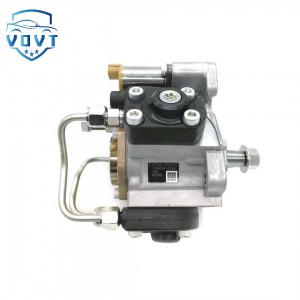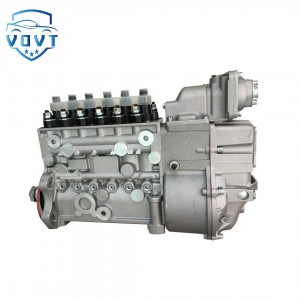High Quality New Fuel Injection Pump BH4AD95R Diesel Pump Diesel Engine Parts
products description
| Reference Code | BH4AD95R |
| MOQ | 1 PCS |
| Certification | ISO9001 |
| Place of Origin | China |
| Packaging | Neutral packing |
| Quality Control | 100% tested before shipment |
| Lead time | 7~15 working days |
| Payment | T/T, Western Union, Money Gram, Paypal, Alipay, Wechat |
Research on diesel oil pump performance optimization and fault diagnosis technology
Diesel engines are widely used in transportation, industrial production and other fields because of their high thermal efficiency and strong power. The diesel oil pump, as the core component of the diesel engine fuel supply system, is responsible for transporting diesel fuel from the fuel tank to the engine combustion chamber and ensuring the provision of appropriate fuel pressure and injection volume under various working conditions. Therefore, the in-depth study of diesel fuel pump has important practical significance.
The working principle of diesel oil pump
Diesel oil pump is mainly composed of pump body, plunger, oil valve, camshaft and other components. Its working process can be divided into three stages: oil inlet, oil pressure and oil return. Driven by the camshaft, the plunger makes reciprocating motion. When the plunger downward, the pump chamber volume increases, the pressure decreases, the diesel oil through the inlet into the pump chamber, complete the oil intake process. With the plunger upward, the pump chamber volume decreases, diesel fuel is compressed, when the pressure reaches the opening pressure of the outlet valve, diesel fuel through the outlet valve into the high-pressure tubing, to the injector oil supply, which is the pressure oil stage. When the plunger continues to travel up to the slanting groove and the return hole, the pump chamber pressure drops, the outlet valve closes, and the remaining diesel fuel flows back to the tank through the return hole, which is the oil return stage. By precisely controlling the stroke and speed of the plunger, the diesel fuel pump can precisely adjust the fuel injection volume and injection pressure according to the engine conditions.
Performance influencing factors
(i) Plunger coupling fit accuracy
The clearance between the plunger and the plunger sleeve directly affects the sealing of the pump and the oil supply. If the clearance is too small, it is easy to cause the plunger stagnation; if the clearance is too large, it will lead to fuel leakage, so that the oil supply is insufficient and the pressure drops.
(ii) the characteristics of the outlet valve
Fuel outlet valve sealing performance, opening pressure and decompression volume and other parameters on the regularity of fuel injection and pressure fluctuations have an important impact. Poor sealing will cause backflow of fuel, affecting the next injection; unsuitable opening pressure and decompression volume will lead to irregular fuel injection, affecting the combustion effect.
(iii) Camshaft profile design
The cam profile of the camshaft determines the movement law of the plunger, which in turn affects the oil supply volume of the oil pump and the oil supply pressure with the engine speed change characteristics. Reasonable cam profile design can make the oil pump in different working conditions can provide good fuel supply performance.
Performance optimization methods
(i) Improve the processing technology of plunger coupling parts
Adopt high-precision processing equipment and advanced grinding technology to improve the matching accuracy of the plunger coupling, reduce surface roughness, reduce fuel leakage, and improve the volumetric efficiency of the oil pump and the stability of fuel supply.
(ii) Optimize the structural parameters of oil outlet valve
Through numerical simulation and experimental research, optimize the parameters such as sealing cone angle, opening pressure and decompression volume of the oil outlet valve to reduce fuel pressure fluctuations, improve the spray pattern, and improve combustion efficiency and engine power and economy.
(iii) the use of electronic control technology
Electronic control of the diesel fuel pump can be based on a variety of engine sensor signals (such as speed, load, intake pressure, etc.) to accurately control the pump's fuel supply and fuel supply moment, to achieve a more flexible and accurate fuel injection control, and further reduce fuel consumption and emissions.
Common Troubleshooting Techniques
(i) pressure test method
By installing a pressure sensor at the oil pump outlet, the change in fuel pressure is measured. During normal operation, the pressure should be within the specified range and fluctuate smoothly. Low pressure may be due to plunger wear, poor sealing of the outlet valve, etc.; pressure fluctuations may be too large the presence of air inside the pump or the plunger movement is not smooth.
(ii) Flow measurement method
The use of specialized fuel flow meter to measure the fuel supply of the pump, compared with the standard value. Insufficient oil supply may be due to plunger coupling leakage, poor oil inlet or outlet valve failure.
(iii) Auscultation
With experienced maintenance personnel using a stethoscope to listen to the sound of the oil pump work. Abnormal noise may indicate a fault such as plunger stalling, camshaft wear or loose internal parts.
The performance of diesel oil pump is crucial to the operation of diesel engines. Through in-depth study of its working principle, performance influencing factors, taking effective performance optimization measures and fault diagnosis techniques, the reliability, durability and fuel supply performance of diesel oil pumps can be significantly improved, so as to enhance the overall performance of diesel engines and meet the increasingly stringent emission regulations and the market demand for high-efficiency, low-consumption power equipment. In the future, with the continuous progress of technology, diesel oil pumps will develop in the direction of higher precision and more intelligent, injecting new vitality into the development of diesel engines.























